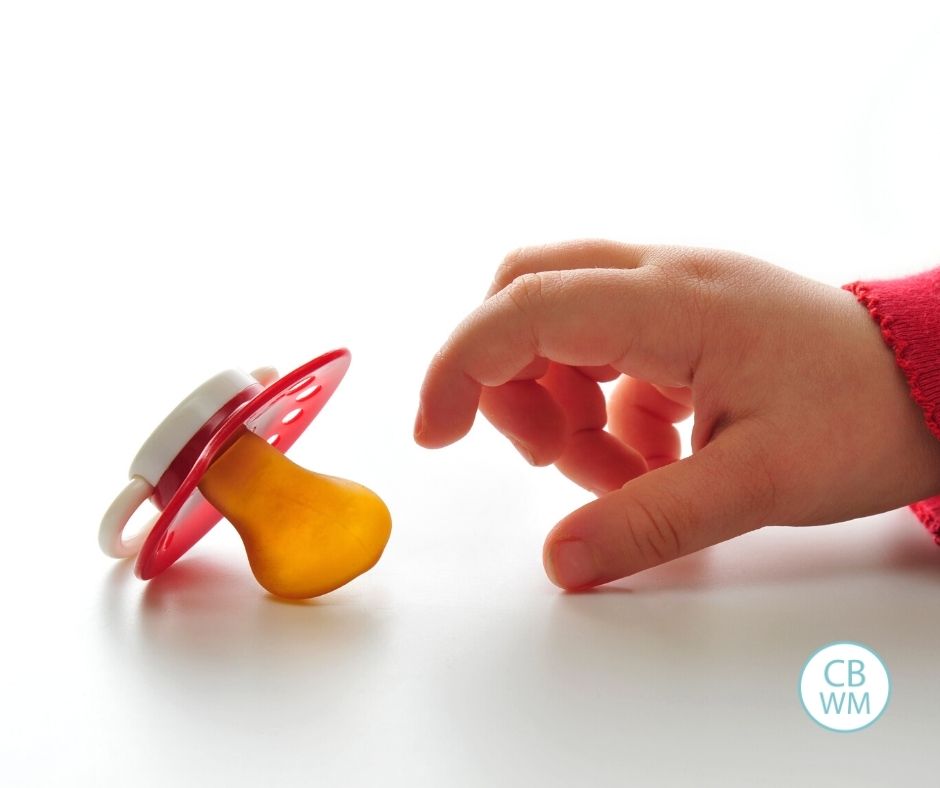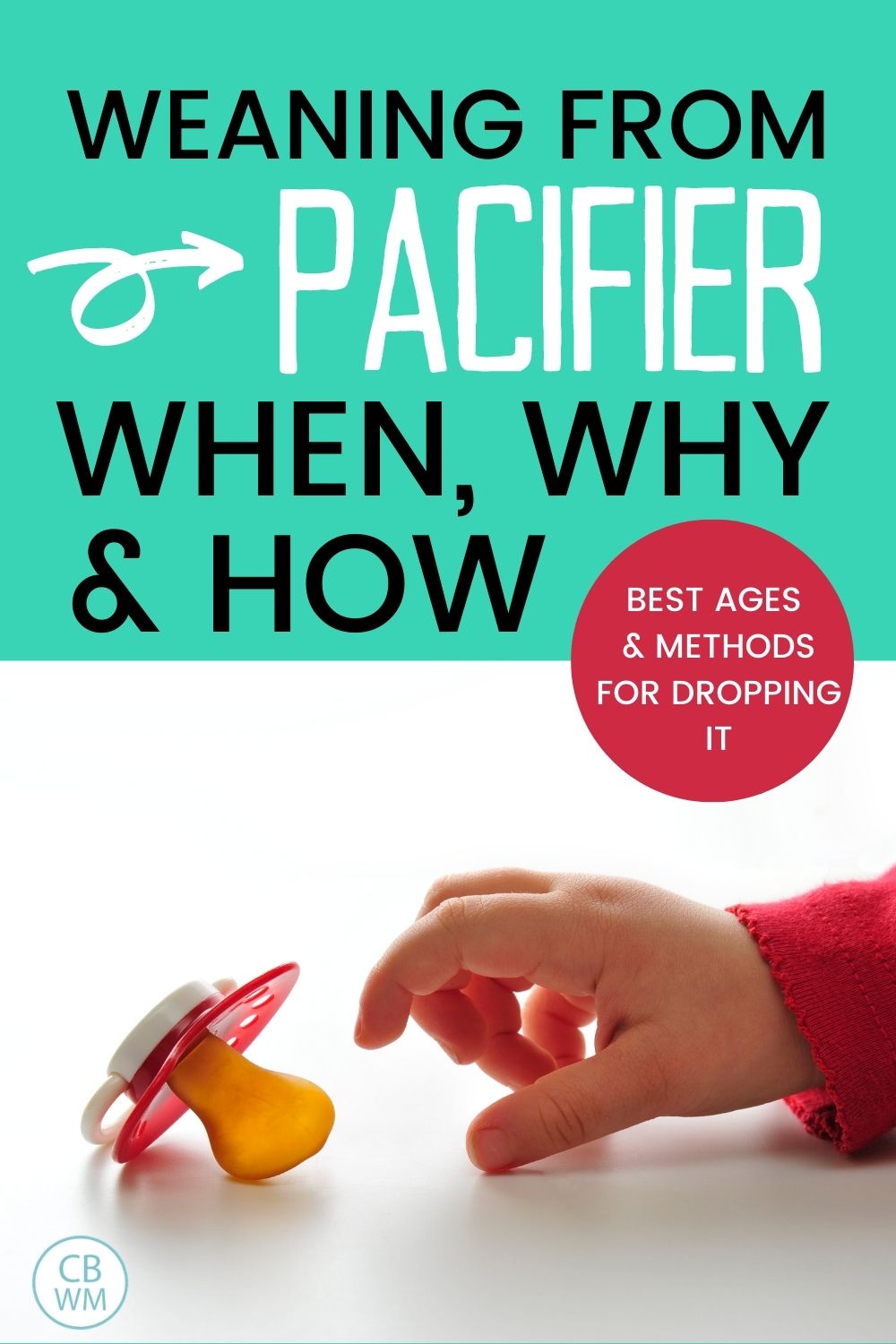Find out the best time to wean from the pacifier. Get the ages, why to do it, and how to be successful with it.

The pacifier can be a tool you love to help your little one sleep better.
Despite that, there will come a day when you will need to wean from the pacifier.
In this post, I will discuss when you should drop the pacifier, why you will need to, and how to do so.
Post Contents
- When To Drop the Pacifier
- 6-7 Months Old
- 9 Months Old or Sooner
- By 2 Years Old
- By 3 Years Old
- 2-4 Years Old
- When You Feel it is Time
- Why You Should Drop the Pacifier
- Causing Sleep Problems
- Interfering with Breastfeeding
- Causing Ear Infections
- Delaying Speech Development
- Creating Dental Issues
- Age of the Child
- How to Wean from the Pacifier
- Limit Use to the Bed or Crib
- Find Alternative Soothing Methods
- Trade for a Toy or Blanket
- Give a Deadline
- Gradually Trim the Pacifier
- Use a Sticker Chart
- Go Cold Turkey
- Stay Positive, Empathetic, Calm, and Firm
- Conclusion
- Related Posts
When To Drop the Pacifier
As with most things when it comes to children, there are many varied recommendations for when to drop the pacifier.
6-7 Months Old
Many sleep experts agree that the easiest time do pacifier weaning is around 6-7 months old. The ironic thing with this age recommendation is that it is also the age babies finally start being able to put their pacifier in independently.
9 Months Old or Sooner
Babies tend to start to form emotional attachments to objects around 9 months old, so if you can drop the binky before that age, it will be an easier weaning process for you both.
By 2 Years Old
The American Dental Association recommends toddlers drop the pacifier by age two or younger.
This recommendation is from a dental standpoint and concern over teeth.
By 3 Years Old
The American Academy of Pediatric Dentistry gives tots an extra year, asking for binkies to be dropped by age three or younger.
2-4 Years Old
The most common age range that the average parent decides to drop the pacifier is in the 2-4 year old range.
When You Feel it is Time
It is helpful to know what is recommended and to know what is typically done. After you know that information, ultimately, you need to decide when it is time.
This will be an easier decision for you to make as we discuss the common reasons “why” people drop the pacifier. Why you are doing it will really drive your when to do it.
Why You Should Drop the Pacifier
There are many reasons that come up to drop binkies. Let’s discuss them.
Causing Sleep Problems
One of the most common reasons for dropping binkies is sleep issues. This is especially true in young babies.
It is very common around 3 months old for the use of a pacifier to lead to sleep problems. You can see nights and naps disrupted. It is common enough I have an entire post dedicated to it.
>>>Read: How Pacifiers Might Be Ruining Your Baby’s Sleep
This post has tips on how to use pacifiers as a tool and help prevent them from becoming something that actually disrupts sleep
Interfering with Breastfeeding
Some moms find that the use of a binky interferes with successful breastfeeding. If you are finding this to be true, it might be time to drop it.
Causing Ear Infections
As your baby gets past 6 months old, using a binky can cause ear infections. If you find that your little one constantly gets ear infections and she also uses a pacifier, you might consider dropping it to help prevent further ear infections.
Delaying Speech Development
Another reason for dropping binkies is delayed speech. This can happen from multiple ear infections. When toddlers and babies have ear infections, they can’t hear as well. Hearing the language is vital to learning it.
It can also happen simply because the mouth is not free to try to talk. You can mitigate this by keeping the binky only in bed.
Creating Dental Issues
You might find that your child’s dentist recommends dropping the pacifier because it is starting to interfere with proper development and alignment of teeth.
Age of the Child
You might simply decide that it is the right age for your child. As you look over the age recommendations above, you will see most experts recommend 3 or younger. They might all have different reasons for the age they have chosen, but that is the most common range.
How to Wean from the Pacifier
Now that you have looked over the age recommendations and the reasons for weaning, you might have decided it is time!
How do you do it? Let’s discuss some tips as well as some methods.
Limit Use to the Bed or Crib
I am always a huge advocate for gently and slowly weaning off of things. It is how I have found the most success as a parent. At times, slow isn’t the best approach, but often times it is.
A great place to start on this journey is to limit the pacifier use to the crib or bed. Only allow it to be used or sucked on in those places.
This is a great habit to start from the beginning. If you didn’t start it from the beginning of baby’s life, you can still make that adjustment at change.
Start by only allowing it in the bed, but don’t limit the time spent in the bed. If your child decides to spend all of her time in bed in order to suck on the binky, consider moving to limiting time spent in bed.
Find Alternative Soothing Methods
If your child is 9 months or older, the pacifier has become a soothing method for him. You will want to help him find alternatives to sucking in order to soothe himself when is is upset or anxious.
Make sure bedtime routines are calm and help your little one unwind and relax for sleep times.
Trade for a Toy or Blanket
Many parents trade the pacifier for a toy or blanket. This allows the child to be excited about the change and can also serve as an alternative comfort item.
Many kiddos will be excited about trading for a toy until it comes time for that first nap or that first time he is upset. Remember to stay firm with the trade.
Give a Deadline
With big life transition, I like to give the child a deadline or fair warning. I don’t just spring on them one day that life is going to majorly change starting NOW.
Instead, I say, “At your birthday (or Easter, summer, Halloween, 3 days from now…whatever) you are going to stop using the pacifier!”
This gives the child time to process and mentally prepare for the change.
When that day arrives, have your child say goodbye. This is a big life change and saying goodbye can bring closure. You might bag them up and thrown them in the garbage or recycling bin together. You can package them up and say “Bye-bye binky!” together.
Gradually Trim the Pacifier
Many parents find great success with gradually snipping off small pieces of the pacifier over time. This is a process that weans the child. It changes the nature of the binky, so it won’t be as satisfying, either.
Use a Sticker Chart
Positive reinforcement works well for encouraging children to make changes in habits. A sticker chart is often very well received by children.
Each nap or night that your little one sleeps binky-free, have her put a sticker on the chart. You can work toward a special date, toy, or book, or you can simply have the satisfaction of filling out a sticker chart!
Go Cold Turkey
Sometimes cold turkey is the way to go. You know your child best and might know anything slow will be too hard. In that case, you don’t limit or don’t slowly snip away. You just throw them away and move forward.
You can limit to bed for a while first to help make the cold turkey be more gradual and gentle, but the actual dropping process can be fast still.
Stay Positive, Empathetic, Calm, and Firm
Expect bad nights and bad naps. You are going to need to dig deep to stay positive. Your kiddo will need you to be empathetic. Her world just got rocked! She has had to majorly change a big piece of her life.
Stay calm with your kiddo if she struggles, but stay firm in your resolve to ditch the paci.
Conclusion
Pacifier usage can be helpful in getting your little one to sleep well. It has also been suggested from the American Academy of Pediatrics that it can help prevent Sudden Infant Death Syndrome (SIDS). So it can be a helpful sleep tool.
But the day comes it needs to be ditched.
This post can help you know when, why, and how.
Related Posts
- How Pacifiers Might Be Ruining Your Baby’s Sleep
- Is it Okay to Use Pacifiers with Babywise?
- When Sleep Props Are Okay (And When to Avoid Them)
- Weaning Thumb/Finger Sucking

